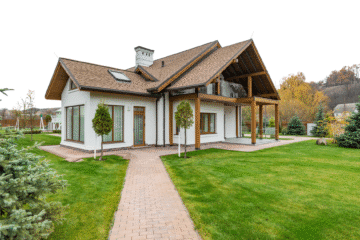If you have a brick patio, it’s important to clean it regularly. Signs that your patio needs cleaning include weed, grass, and moss growth, mold or mildew, dark stains, sinking spots, and drainage issues. Regular soft wash cleaning will help protect your outdoor space, extending its lifespan, and preventing expensive repairs.
High-pressure power washing can damage surfaces and leave behind residue that can harm the environment. Soft wash brick patio uses low-pressure nozzles with a biodegradable cleaning solution to safely and thoroughly clean your home’s exterior. This friendly method reduces risk to your brick and concrete surfaces compared to pressure washing service methods.
How to Clean a Brick Patio
Brick patios are susceptible to many of the same problems as other exterior surfaces around your home. UV rays fade the colors of the brick, rain washes sand out of the joints, and weeds and ants find their way into the cracks between pavers, creating an unsightly appearance. A regular cleaning schedule will help keep your brick looking fresh and its best.

Soft Wash Brick Patio
Begin with a thorough sweep to remove all dirt and grime, debris, and tree limbs. Next, hose off your patio to rinse off loose surface dirt. Make sure to wear protective eyewear and rubber gloves as you spray the patio.
Since brick is a porous material it may require more frequent cleaning than natural stone pavers, which typically can be cleaned annually. Once the patio has been thoroughly swept and rinsed, consider applying a masonry sealer to protect against stubborn stains and dirt returning.
It is also a good idea to pour polymeric sand in the cracks between pavers. This is a blend of traditional sand and special additives that reduce weed penetration and washout with rain, preventing your patio from becoming slippery.
Preparation to Soft Wash Your Patio
Before starting the softwashing process, we will need to inspect your brick patio for any signs of damage. We need to be sure there are no cracks or broken bricks that could fall off, and that the sand between the bricks is in good condition.
We will also need to prepare the cleaning area by covering any surrounding plants with plastic. It’s important that any weeds or other plants are not exposed to the cleaning chemicals used in the soft washing process.
During the soft washing patio process, a high concentration mix of cleaning chemicals is applied with a low-pressure wash system to your home or surface. Typically, the solution contains bleach (sodium hypochlorite) along with a surfactant and water. This organic cleaner kills any mold or mildew spores, algae, moss, and other plant life on the roof. It also penetrates the root systems to ensure complete removal and prevent regrowth.
A solution with a lemony odor eliminator is also included to quickly eliminate any lingering odors such as vomit, feces, garbage, smoke, or mildew that might sit on the roof. Afterward, a Plant Wash neutralizing agent is used to ensure that any chlorine in the soil won’t harm any vegetation near your house.
Power or Pressure Washing Surfaces
Power washing a brick patio is a great way to get rid of any dirt or debris that has built up on your brick patio. It also helps to remove stains caused by spilled food or other substances, and it can restore your patio to its original color.

Soft Wash Brick Patio
Before you start power washing, clear away any furniture or objects that are on the patio so that you can work more easily. Then, wet the surface of the patio using a garden hose and set up your power washer with the appropriate nozzle. Follow the instructions in your owner’s manual to determine the best pressure and setting for your power washer.
Once the nozzle is in place, begin spraying the brick patio, working in small sections and overlapping each stroke. Be sure to rinse the brick patio thoroughly afterward. If any stains remain, try scrubbing them with a small stiff-bristled brush and then rinsing again. This method is less likely to damage the brick than bleach, which is harmful to it.
Post-Wash Care
Once your patio is clean, you need to prepare it for the long term. A proper brick foundation will support the pavers and prevent weeds from invading. If you have trees or shrubs that will be in the location of the patio, build around them rather than removing them; this preserves their roots while providing them with an area to receive adequate moisture.
Lay landscape fabric over the gravel; this suppresses weeds and separates the gravel from the sand layer. Pour two inches of sand over the landscape fabric, using a 2-by-4 as a screed to level and smooth the surface.
Use polymeric sand in the joints between the pavers to stiffen them and help hold them in place, and to prevent weed intrusion. Gently spray the sand with a garden hose to activate it and begin the stiffening process.
For a quick quote or if you have questions, please contact us for comprehensive exterior cleaning services. Softwashing is the safest, most effective way to maintain the beauty and safety of your brick patio and concrete pool areas.
Johnny Tsunami
605 Strander Blvd, Seattle, WA 98188, United States
(206) 899-0003









